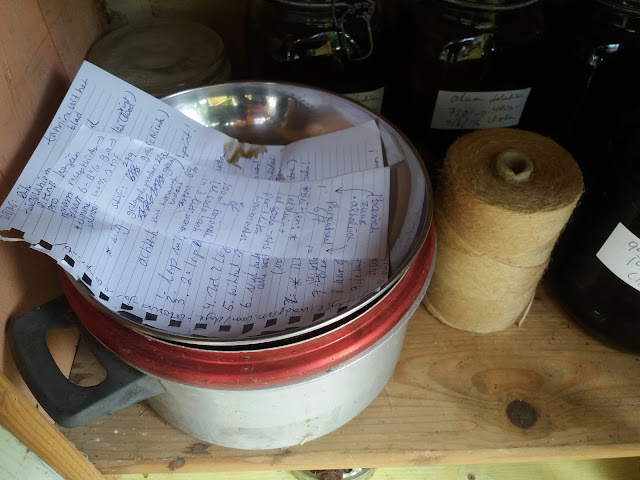from back to front, i.e. images taking one back in time
A view of the dye cupboard on the porch; it's where I keep most of my dyeing utensils; a glimpse of my not-so-methodical notes: usually I start reading on the internet and in books, looking for answers, whilst reading I realise I won't remember it all, or maybe not even a little bit and so I grab the first bit of paper I can get my hands on and start making notes, turning the piece of paper upside down when visiting another blog/book for info! and so on.....
I have a folder with most of my dye related notes which I cannot locate, I think I might have left it at Marijke's* place. I was there last week for an entire day's kind of private workshop on dyeing cellulose fabrics.....
We washed lots of cellulose fibres in soda/water, left them soaking for two hours, I learnt this is how one should start the dyeing-process and amidst all our conversations and researching I fell in love with the whole concept of home dyeing again.
Once back home Django and I went for an evening walk and I collected oak apples (tannin!) for a home-made mordant.
Finally, a week later I got round to grinding the oak apples in my granny's old electric coffeegrinder, measured the correct amount of powder to dry cloth (6-8% powder per 100% fabric) both of which I was able to weigh exactly on new scales!
 13 bundles in pot, I have used willow from our own garden and walnut from just across the road leaves for eco prints, one hopes
13 bundles in pot, I have used willow from our own garden and walnut from just across the road leaves for eco prints, one hopes


 |
after the 24 soak in the oak-apple-mordant, the various bits of fabric, which were white to begin with, have different colours, so even though they're all cotton, the result is different, maybe thanks to different texture.
I had expected the mordanted fabrics to remain more or less white (the theory is oak apple is rich in tannin, good for mordanting and has the advantage of being colourless), maybe the pan wasn't really clean, or maybe
the oak apples were too old and therefore did give more colour; perhaps even the aluminium pot reacted with the mordant.
be that as it may, I did try to prepare and mordant as per instructions:
1. wash cloth in soda for 2 hours, rinse thoroughly.
2. prepare oak apple mordant: grind oak apples to powder.
3. steep 6-8% powder per 100% fabric in pot with clean water, much like a tea, stir well. I couldn't find out how much water was required so decided to allow as much water as was necessary to cover all the fabric I wanted to mordant.
4. add fabric to still warm mordant, leave to steep for 24 hours.
5. remove fabric from pot, wring excess moisture, do not wash; use straight away as I have done, or leave to dry and store with tags!
6. make bundles: I have chosen willow and walnut leaves as I want to use local ingredients. Place leaves on cloth, the back is supposed to give even better results, fold fabric double or place another bit of fabric on top, roll around a stick
7. place bundles in pot with clean water, as I have done today, or into a dye/mordant; bring to the boil, simmer for 2 hours, remove from heat source, leave to steep for 24 hours, at least
so this is what I have done and I will now have to be patient
for the forseeable future I want to focus on learning about the best (tannin)mordant I can make with local ingredients and print and dye with willow, as I love this tree
|
 |
| cotton in the mordant |
 |
before.....
I used hazel sticks for the bundles as I have cut back the hazel hedge on our front drive, helping me feel a little less guilty ..........it didn't start out as such a major thing when I started yesterday afternoon, but once I got going I decided to be radical and now it's very bare and light....hmmmm looking forward to new growth next year! and I'll be making an extra shelter for firewood in between the hazel stumps
|





















Comments
And today I go to class as well ... asemic encaustic collage
as i begin to learn what plants i will be able to partner with here.
it's all just beginning from beginning for me. I will wait to hear
more!